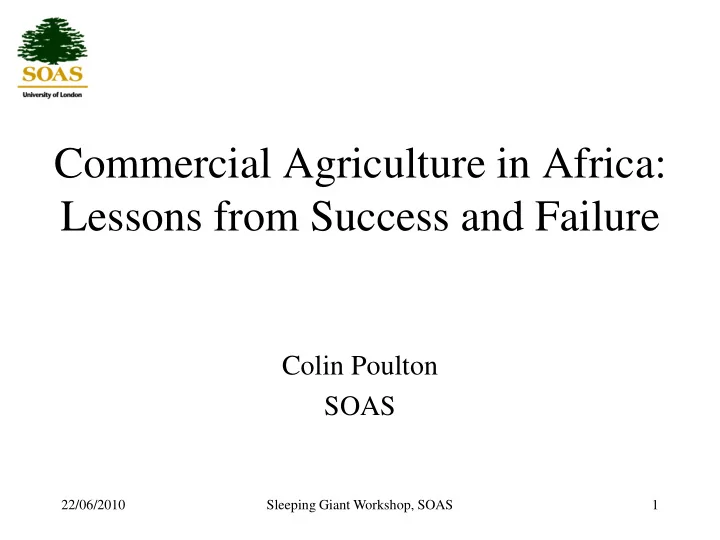

Commercial Agriculture in Africa: Lessons from Success and Failure Colin Poulton SOAS 22/06/2010 Sleeping Giant Workshop, SOAS 1
Background • Background studies for “Sleeping Giant” report • All reports can be downloaded from: http://go.worldbank.org/XSRUM2ZXM0 • “Critical review of successes and failures in any form of commercial agriculture in Africa” • Commercial = production primarily for the market • Three farm systems: – “family” and “large - scale commercial” farms dominate in different cases – “emerging commercial farmers” more difficult to identify … – … and where they were observed, they did not “emerge” from the ranks of smallholders 22/06/2010 Sleeping Giant Workshop, SOAS 2
Case Studies Post-WW2 UK CDC Geoff Tyler Livestock Peter Hazell Cotton Colin Poulton Staple Foods Maize, cassava, rice Hazell and Poulton Tea S/E Africa Geoff Tyler Sugar S/E Africa Geoff Tyler Horticulture S/E Africa Geoff Tyler Oil Crops Senegal groundnuts, Kenya sunflower Poulton and Tyler Cashew Mozambique, Tanzania Colin Poulton Tobacco Malawi Poulton, Kydd, Kabambe 22/06/2010 Sleeping Giant Workshop, SOAS 3
Defining Success • Sustained competitiveness – Expect this to be associated with production increase – However, production increase need not be associated with poverty reduction • Mali cotton in 1990s: production expansion (no alternatives) as world prices fell • Range of environmental impacts possible – but unlikely to maintain starting stock of all forms of natural capital – Cases where commercial agriculture should not proceed at all are rare, but need to identify and manage impacts common 22/06/2010 Sleeping Giant Workshop, SOAS 4
Africa’s Comparative Advantage • Crops where agro- ecological conditions are “ideal” – E.g. tea, coffee, sugar • Crops where aspects of production are very labour intensive and difficult to mechanise – E.g. cotton, horticulture, tea • One or both necessary to offset cost disadvantages: – infrastructure, capital, fertiliser, land (LSC) • Counter case: Senegal groundnuts • Examples of “created” competitive advantage: Kenya horticulture, Malawi tobacco 22/06/2010 Sleeping Giant Workshop, SOAS 5
Comparative Advantage II "International" Crop Prices 3000.0 2500.0 2000.0 US$/ton Mean "International" Price 2001- 1500.0 2006 1000.0 500.0 0.0 Cashew Groundnuts Sugar Seed Cotton Tea Cassava Pellets Tobacco Rice Maize No examples of export success in low value crops (Nigerian cassava?) 22/06/2010 Sleeping Giant Workshop, SOAS 6
Trade Volumes (Diao et.al. 2003) Exports Intra-SSA Imports Intra-SSA US$b p.a. Share (%) US$b p.a. Share (%) Cereals 0.49 25% 2.84 11% Meat/Livestock 0.46 63% 1.14 10% Total Staples 1.01 44% 4.09 11% Fish 2.40 9% 0.79 27% F+V 2.45 6% 0.44 31% Oilseeds/oils/fats 0.68 25% 1.30 15% Total Non-trad. 6.80 11% 3.86 21% Traditional Exports 9.02 5% 1.35 33% Other 1.57 12% 0.83 23% TOTAL 18.40 10% 10.13 19% 22/06/2010 Sleeping Giant Workshop, SOAS 7
Domestic and Regional Markets • African demand for basic food products > US$50b p.a. – Growing rapidly with population and incomes – Diao et.al. (2003) forecasted doubling in consumption by 2015 • Quality and safety requirements modest – Southern African meat case study • Import substitution, especially in landlocked countries – Challenge of supplying large coastal cities • Regional markets as “dead end” or springboard? 22/06/2010 Sleeping Giant Workshop, SOAS 8
(Transaction) Cost Advantages of Small vs Large Farms Small Farms Large Farms √ Unskilled labour supervision, motivation, etc √ Local knowledge √ Skilled labour √ Market knowledge √ Technical knowledge √ Inputs purchase √ Finance / capital √ Output market access √ Product traceability and quality assurance √ Risk management 22/06/2010 Sleeping Giant Workshop, SOAS 9
Smallholder vs Commercial: Case Study Experience • Large-scale commercial advantage: – Export horticulture: safety standards – Sugar: irrigation infrastructure – Tobacco (flue cured): barns + perishability • Smallholder advantage: – Maize (and other staples), cotton, cashew, burley tobacco • No clear winner (and/or insufficient evidence): – Tea, livestock, oilseeds 22/06/2010 Sleeping Giant Workshop, SOAS 10
Desirable State Roles No Sector-Specific Sector-Wide Club Goods Investment (e.g. bulk handling) LSC “farm Enabling environment Enabling environment + system” ensure club good provision Smallholder Enabling environment Enabling environment + “farm system” + ensure service ensure club good provision (competition provision + ensure vs coordination) service provision Institutional arrangements are critical for smallholder competitiveness 22/06/2010 Sleeping Giant Workshop, SOAS 11
Importance of Agricultural R&D Groundnut Yield (unshelled, kg/ha) in Selected Countries, 1965- 2004 (source: FAOSTAT) 4000 3500 Argentina 3000 China 2500 India kg/ha 2000 Nigeria Senegal 1500 United States of America 1000 WORLD AVERAGE 500 0 5 8 1 4 7 0 3 6 9 2 5 8 1 4 6 6 7 7 7 8 8 8 8 9 9 9 0 0 9 9 9 9 9 9 9 9 9 9 9 9 0 0 1 1 1 1 1 1 1 1 1 1 1 1 2 2 Year No case of NARO-driven productivity increases creating international competitiveness … 22/06/2010 Sleeping Giant Workshop, SOAS 12
Staple Food Crops • Relationship between subsistence and cash crop production: – Cash crop production rarely jeopardises food security (von Braun and Kennedy 1994) – Risk or cost of food purchase often discourages cash crop production (Fafchamps 1992, Jayne 1994) • Policies to promote smallholder commercialisation require either: – Policies to improve efficiency of staple food markets – Policies to promote staples intensification 22/06/2010 Sleeping Giant Workshop, SOAS 13
Recommend
More recommend